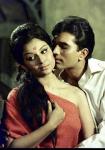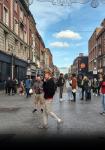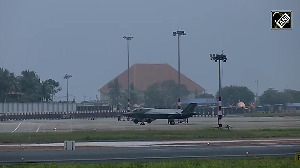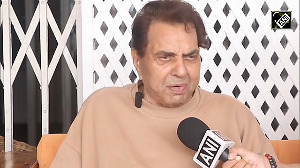Lighting masters and engineers, vendors and project managers rubbed shoulders last week at Light India International 2005, an international exhibition and conference on lighting technology organised at New Delhi's Pragati Maidan.
The reason for the exciting contingent is obvious -- a booming economy, a large number of infrastructure projects, and a technology gap that needs to be rapidly filled.
Among them was German light designer Gert Hof who, for two decades, has designed and produced monument light displays using light, music and fireworks -- directing light shows for the Millennium events at the Acropolis, Berlin, Beijing and Budapest, and the Red Square at Moscow as part of his repertoire.
Fascinated by the speed of light and the way it leaves its traces, "Lighting technology is interesting only as a tool," Hof believes. "I will never be a slave to technology but will use it for satisfying my artistic instincts."
The timing of light displays is crucial, he says reminiscing about the celebrations at Budapest where the bridge over the river Danube was lit up with 25,000 blue neon lights for 10 seconds, sufficient to perceive its beauty, click photographs and embed an image in the mind.
Hof uses Ireos pro space white lights that have a range of 70 km in the sky, and Syncrolites for colour. "With the white lights, one can have a dialogue," he feels.
And if the Commonwealth Games have anything to do with it, they just might be working on projects in Delhi, Agra and Rajasthan. While nothing has been signed yet, there is a general understanding that illuminated monuments could contribute their bit to converting New Delhi into a World City in time for 2010.
Japanese lighting designer Kaoru Mende balances the fine line between practicality and aesthetics, he says lighting designs have seen tremendous changes in trends. "The biggest has been the communication with clients who have become aware of the effects of lighting design and are willing to hire lighting designers," says Mende.
Technology too is equipping lighting designers to experiment -- from halogen lights to compact metal halide lamps -- "it's becoming more sophisticated" and Mende predicts LEDs dominating lighting 10 years hence.
With lighting techniques similar globally, Mende feels that "globalising trends makes it confusing. Lighting specific to cultures should be highlighted as each city has its own unique culture of lighting."
While he has been asked by the Singapore government to prepare a masterplan for lighting Singapore, Mende has been researching Indian aesthetics of lighting after being assigned the Lodhi Hotel project (being converted into an Aman resort) and the Westend Hotel in New Delhi.
"For the Aman project, I want to highlight the jali work of the structure. The centre court lighting design is very important as the resort will be surrounded by the city, so every visual point has to focus on the centre court," he proposes.
Elsewhere, Maurizio L M Mussati, who handles international operations for Italian lights company Flos, says the Indian market is still to take off. "Maybe it will be mature in another two years," he says.
For now, Flos has retailed through an Indian partner at the Vis-a-vis store, and has been instrumental in opening up the market for luxury lights (designed by Philippe Starck and Casteglioni, among others) for architectural projects.
However, as the market grows, Mussati is confident of the stand-alone, retail market becoming stronger than even China. "Awareness levels here are quite high," he says.
And yes, Flos anticipates splitting itself evenly between retail and corporate sales. "Even though clients are cost conscious, some architects will not settle for less than Flos," he suggests, "even in developing markets like India."






